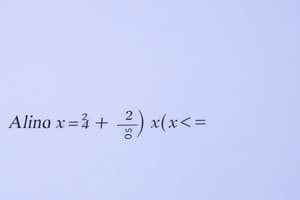Podcast
Questions and Answers
Which of the following applications does the Mean Value Theorem NOT directly assist in?
Which of the following applications does the Mean Value Theorem NOT directly assist in?
- Proving the existence of roots
- Establishing properties of functions, such as monotonicity
- Determining the concavity of a function (correct)
- Analyzing function behavior in optimization problems
In the context of the Mean Value Theorem, what does the variable c represent?
In the context of the Mean Value Theorem, what does the variable c represent?
- The minimum point on the function
- The maximum point on the function
- A point in (a, b) where the derivative equals the average rate of change (correct)
- The average rate of change over [a, b]
What are the two necessary conditions for a function to satisfy the Mean Value Theorem?
What are the two necessary conditions for a function to satisfy the Mean Value Theorem?
- Continuity on [a, b] and differentiability on (a, b) (correct)
- Continuity on [a, b] and differentiability on [a, b]
- Continuity on (a, b) and differentiability on [a, b]
- Differentiability on (a, b) and continuity on (a, b)
Which statement is true about Rolle's Theorem?
Which statement is true about Rolle's Theorem?
What does Lagrange's Form of the Mean Value Theorem state about the function's behavior?
What does Lagrange's Form of the Mean Value Theorem state about the function's behavior?
Flashcards are hidden until you start studying
Study Notes
Mean Value Theorem
Differentiation
- The Mean Value Theorem (MVT) applies to functions that are continuous on a closed interval [a, b] and differentiable on the open interval (a, b).
- It guarantees the existence of at least one point c in (a, b) where the instantaneous rate of change (derivative) equals the average rate of change over [a, b].
Continuity
- For MVT to hold, the function must satisfy two conditions:
- Continuity: The function must be continuous on the closed interval [a, b].
- Differentiability: The function must be differentiable on the open interval (a, b).
- If either condition fails, the MVT may not apply.
Application in Calculus
- MVT is used to:
- Establish properties of functions (e.g., monotonicity).
- Prove the existence of roots (e.g., using the intermediate value theorem).
- Analyze function behavior in optimization problems.
- It can be applied to derive other results, such as Taylor’s theorem and L'Hôpital's rule.
Lagrange's Form
- The formal statement of the Mean Value Theorem:
- If f is continuous on [a, b] and differentiable on (a, b), then there exists at least one c in (a, b) such that:
- ( f'(c) = \frac{f(b) - f(a)}{b - a} )
- If f is continuous on [a, b] and differentiable on (a, b), then there exists at least one c in (a, b) such that:
- This means that the slope of the tangent line at c (f'(c)) equals the slope of the secant line connecting points (a, f(a)) and (b, f(b)).
Rolle's Theorem
- A special case of the Mean Value Theorem:
- If f is continuous on [a, b], differentiable on (a, b), and f(a) = f(b), then there exists at least one c in (a, b) such that:
- ( f'(c) = 0 )
- If f is continuous on [a, b], differentiable on (a, b), and f(a) = f(b), then there exists at least one c in (a, b) such that:
- This indicates that there is at least one point where the tangent line is horizontal, implying a local maximum or minimum in (a, b).
Mean Value Theorem
- The Mean Value Theorem (MVT) applies to functions continuous on the closed interval [a, b] and differentiable on the open interval (a, b).
- MVT ensures the existence of at least one point c in the interval (a, b) where the derivative equals the average rate of change over [a, b].
Conditions for MVT to Hold
- Continuity: The function must be continuous over [a, b].
- Differentiability: The function must be differentiable throughout (a, b).
- If either condition is not met, MVT does not necessarily apply.
Applications of MVT
- Helps establish properties of functions, such as monotonicity.
- Aids in proving the existence of roots through methods like the intermediate value theorem.
- Useful in analyzing function behavior within optimization problems.
- Serves as a foundation for deriving results including Taylor’s theorem and L'Hôpital's rule.
Lagrange's Formulation
- Formal statement: For a function f continuous on [a, b] and differentiable on (a, b), there exists at least one c in (a, b) such that:
- ( f'(c) = \frac{f(b) - f(a)}{b - a} )
- This indicates that the tangent line's slope at point c matches the slope of the secant line connecting points (a, f(a)) and (b, f(b)).
Rolle's Theorem
- A specific version of the MVT: If f is continuous on [a, b], differentiable on (a, b), and ( f(a) = f(b) ), then there is at least one point c in (a, b) where:
- ( f'(c) = 0 )
- This condition signifies the presence of a horizontal tangent line at least once in (a, b), suggesting a local maximum or minimum.
Studying That Suits You
Use AI to generate personalized quizzes and flashcards to suit your learning preferences.




